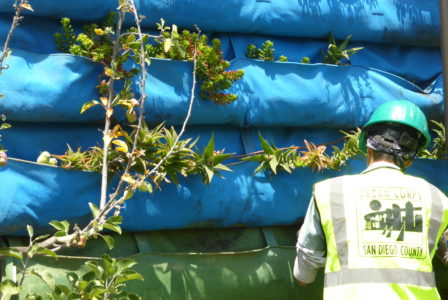Facts and Ideas About Conserving Resources – Part 2
The Garden Club’s May meeting took place at the SDG&E Energy Innovation Center. Last month’s article dealt with what the Center has and does. The second part of their presentation showed practical ways to save energy. As in the overall view of California’s effort to stem the waste of energy, this portion is called Net Zero. Net Zero is a situation wherein you replace all the energy you use within the year.

The Center’s sustainable garden features planters made of sturdy recycled plastic bottles with rigid frames.
The first step is to gain knowledge. This means knowing how and when you use energy; then you create a plan to lower how much you use. You also look for recommendations for savings.
One of the most common ways to save energy is with lightbulbs. What kind do you use? Incandescent bulbs are no longer being manufactured. This bulb lasts about 1,200 hours and uses 60 watts. A 14 watt Compact Florescent Light (CFL) bulb lasts 8,000 hours. An eight watt LED will last 25,000 hours. The LED is definitely pricier: $8 a bulb. The incandescent costs $2.50 and the CFL $4.50. However, the LED bulb lasts over three times the span of a CFL, and it has almost 21 times the lifespan of the incandescent. It only costs $.00032 per hour over its lifetime. Another saving is that SDG&E has a rebate for replacing incandescent bulbs with LED. Over 20 years, your total operating costs per bulb are $367 for the incandescent; $87 for the CFL, and $46 for the LED. You save nothing with the incandescent bulb; you save 77 percent with a CFL; and with the LED you save 87 percent.
During the day, the Center uses Energy Star-rated skylights to reduce the need for electric lighting. They use both solar tracking, utilizing a GPS and automated mirrors to follow the sun, and prismatic solar collectors, where the panels are stationary, relying on the sun to strike its prisms.
A small investment may mean big savings. For example, at home you need to turn off the power when you are not using it. Turning any appliance off when it isn’t actually in use really saves energy and money. However, buying and using smart power strips make turning off appliances easy. If the LED light of your appliance is on, it is using energy. Buying and apply weather stripping to windows and doors saves too. Neither hot air nor icy air can get through it. Upgrading appliances to high-efficiency (HE) is another energy saver.
The floors in the Center’s lobby area are made of aspen wood scraps. Aspen is renewable; if cut properly, its stump will grow into a new tree. All the scraps and other bits of wood are combined to create a very durable fabric to be used as carpet or wall cover. Any remaining scraps are used for fuel. In another part of the building we saw recycled rubber tires used as carpet. This flooring did smell of tires whereas the aspen looked and smelled better. I never saw the floor which was made from used tennis balls, but it must have been interesting.
Checking online for rebates on appliances, HVAC, lighting, refrigeration and the like is a way to learn how to lower the cost of your energy-saving investments. There are programs that pay you if you reduce your usage during peak hours. For more information, visit sdge.com/residential.
Another savings area is water usage. SDG&E showed us the landscaping in the parking lot. There is also a lovely courtyard with a vertical succulent garden; it is watered by a drip irrigation system. The wall can serve as insulation by reducing heat gain and air conditioning needs. It improves air quality by giving off oxygen. Roof gardens can insulate as well, but its oxygen goes to the neighborhood.
The Center irrigates using rainwater using various systems for collecting it. Water goes via a drip system directly to the roots, promoting plant health and conserving water. Excess water is collected in a tank and is reused as irrigation water.
The Center’s sustainable garden features planters made of sturdy recycled plastic bottles with rigid frames. As the Center’s landscaping uses drip irrigation, so does this garden. Plant filled bags line some of the garden’s walls as well. Every square inch is utilized with little or no waste. The beds can be moved, but filled their weight requires great muscle power or a mechanical device.
In the garden was a large white rectangular container. A sign announced it was for thermal energy storage. It makes ice at night when energy used is down and costs are lower. On hot days the ice melts to deliver cooling into an existing air conditioning system. The air conditioner’s normal cooling system turns off in the afternoon (peak usage and most expensive hours. Refrigerant, cooled by the ice, now goes into the AC system.
Next month’s article will conclude the discussion of the SDG&E Energy Innovation Center. Mission Hills Garden Club membership is $35 per year or $50 for a couple. Meetings are held the last Wednesday of the month at the church at 4070 Jackdaw between Fort Stockton and West Lewis from 6 p.m. until 8 p.m.
Category: Events, Local News







